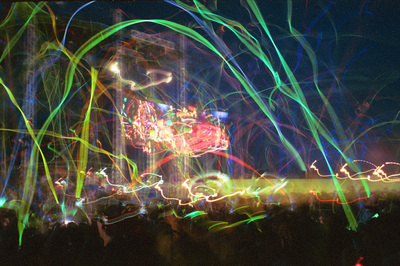|
Glow sticks are nostalgic, whether seen though a child's eye of interpreted by every adults inner youth. Patented in 1977, the glow stick consists of hydrogen peroxide and phenol oxalate housed in a plastic tube, with one solution housed in a glass capsule that when snapped a chemical reaction occurs causing the florescent dye glows. The light omitted cannot be turned off, which is why glow sticks do in fact serve some sort of practical purpose during emergency situations.
I guess that means that most ravers and Phish show attendees are in luck should a catastrophe happen. While most likely inebriated by copious amounts drugs and alcohol, they're enamored by the trails from the flying florescent fireworks. Whether in Ibiza, Goa, Berlin or some hippy Burning Man Full Moon Party people spend hours and quite possibly days and years staring at glow sticks; twirled on shoestrings and or launching back and forth by a crowd. Glow sticks enhance the party, taking it to another dimension enhancing the experience as something from another planet or video game. Finally thanks to glow sticks you can step outside your comfort zone, set your body free, while getting whacked in the face with glowing sticks. Spike TV's show 1000 Ways to Die depict's one raver's fatal love affair, where by injecting the glow stick's mixture the President of the Idiot convention ends up taking his life. It is not hard to fathom how much time the poison control and emergency services waste on glow sticks alone, my kid just swallowed one while this dude just got one lodged in his asshole. One day it we can all expect to come out of the ocean with all our orifices filled with glow sticks and when cutting into a chicken or fish find a glow stick still glowing, especially since it was killed and immediately frozen. But aside from the advert risk, the real question is what are the environmental repercussions? Do we really need these trippy toys or tools to enhance already a doe experience? Glow sticks are not recyclable, so until a program is devised or the party stops they will continue to be manufactured and purchased in the billions.
1 Comment
JJ
2/20/2014 10:13:58 am
Love it. Get some for KP!
Reply
Leave a Reply. |
LAJ
100 Objects of Popular and Material Culture is an blog exploring the manifestations of human consumption and commodity-ization. The purpose of this experiment is to explore material and popular culture in contemporary society by using objects and concepts to prompt wider questions and reflections. So by emulating The British Museum's and Neil MacGregor's format of A History of the World in 100 Objects I plan to satirically analyze and reinterpreted 100 material culture objects over the course of 2014. Material Culture is the study of our culture's consumption of stuff; namely the manifestation of culture through material productions where people's perceptions of objects is socially and culturally dependent. With this, objects reflect conscious and unconscious beliefs on the the individuals who fabricated, purchased, or used them, and by extension the society where they live. So examining materiality, cultural truths and societal assumptions may be discovered. As anthropologist Arjun Appaduai states "in any society the individual is often caught between the cultural structure of commodity-ization and his own personal attempts to bring a value and order to the universe of things." Objects and commodities make up a much larger symbolic system consisting of want and need, socio-economic status, fashion, etc. Often times form follows function whether the commodity, market, and or consumer forever evolve around one-another. Philosopher Pierre Bourdieu's theories of capital flow full circle; where regardless if you are a minimalist or a hoarder the world is made up of things and everyone will leave their footprint on the earth. So by humorously analyzing marketed objects and concepts, hopefully this blog will provide further incite into ideas of over-consumption, a disposable society, consumerism vs. anti-consumers, planned obsolescence vs. sustainability, as well as the greater good of mankind and future generations. Archives
March 2015
Categories |








 RSS Feed
RSS Feed